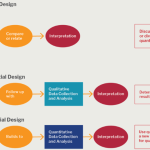What is the average time duration from paper submission to acceptance/rejection decision in an ISI journal?
December 26, 2024
Exploring Qualitative vs. Quantitative Research: Choosing the Right Approach
December 26, 2024In the hallowed halls of academic research, where the integrity impact of scholarly work are paramount, there exists a guardian of excellence: the peer review process. It is the unseen crucible through which all academic papers must pass before claiming their place in the annals of scientific and scholarly contribution. For many researchers, the journey from manuscript submission to the eagerly awaited decision from an ISI journal is akin to sailing through uncharted waters—filled both anticipation and trepidation. This path is intricate, paved with critical evaluation and constructive feedback, but fear not; you are not meant to navigate it alone. In our latest comprehensive narrative, “Understanding the Peer Review Process: Timeline from Submission to Decision in ISI Journals,” we will serve as your beacon, illuminating each step with clarity and insight. Join us as we delve into this meticulous process, offering you the knowledge and strategies to enhance your voyage from submission to publication, fostering not only the advancement of science but your growth as a researcher in your field.
Researchers’ step-by-step guide to understanding the peer review process
The peer review process is an essential component of publishing, guaranteeing the rigor, credibility, and trustworthiness of the scientific literature. For researchers who wish to disseminate their findings, it is crucial to comprehend and navigate this process. Here is a detailed tutorial outlining the necessary steps to demystify the essential stages of peer review.
Step 1: Submitting
The process of submission marks the commencement of the trip. Researchers must select an acceptable scholarly journal that aligns with the goals and objectives of their study.It is essential to thoroughly examine the journal’s submission instructions and strictly follow its formatting standards. Once the research manuscript is ready, it must be uploaded using the online submission procedure provided by the publication.
Step 2: Editorial Evaluation
After submission, the editing team, which includes the editor-in-chief or the handling editor, conducts a first evaluation. This phase guarantees that the manuscript aligns with the objectives of the journal, thoroughly examines its quality, and verifies adherence to style guidelines. If it meets these criteria, it progresses; if it does not, it is swiftly rejected.
What is the average time duration from paper submission to acceptance/rejection decision in an ISI journal?
Step 3: Evaluate Assignment
After passing the initial editorial inspection, the next step is the peer review assignment phase. In this process, the article is transferred to individuals who specialize in the relevant field, referred to as reviewers or referees. Reviewers are anonymous to ensure objectivity. They possess the necessary knowledge to provide significant critiques of the work.
Step 4: Conducting a Peer Review
During the process of peer review, reviewers carefully analyze and evaluate the content, methodological rigor, originality, and significance of the manuscript. They identify the strong and weak points of the research, highlight any mistakes or missing information, and provide recommendations to improve the quality of the publication. The transmission of their assessments typically conforms to a predetermined timeframe that is specific to each journal.
Step 5: Determination
After completing the peer review process, the reviewers communicate their findings to the editor, who then makes a well-informed choice. Possible outcomes of the manuscript evaluation process include complete approval, the requirement for small or significant adjustments, or complete rejection.
Step 6: Review and resubmission
Modification requests result in the initiation of the revision stage. Authors are provided with comprehensive feedback, which they are required to carefully evaluate and include into their paper revisions. The resubmitted manuscript is accompanied by a detailed response letter that explains the changes made. This allows editors to easily keep track of the alterations.
Step 7: Final Determination and Release
The ultimate authority rests with the editor, who reassesses the polished text, taking into account any further advice from reviewers if required. After being accepted, the work progresses through various production steps including copyediting, typesetting, and proofreading, ultimately resulting in its publishing.
Insider Strategies for Getting Your Research Published in ISI Journals
Step 8: After publication
Once their research is published, the researcher’s responsibility changes to distributing and advocating for their findings among both the scientific community and the general public. Post-publication obligations encompass activities such as collaborating with colleagues, addressing feedback, and undertaking further research endeavors.
Peer review continues to serve as the guardian of academic excellence and an essential component of scholarly activity. By comprehending every phase of this complex process, researchers can improve the chances of their paper successfully navigating this demanding evaluation and finally disseminating their insights to the global community. Having a keen understanding of the peer review process enables individuals to make significant contributions to the broader body of knowledge in their respective fields.
Maximizing Your Research Impact: Strategic Tips for Navigating ISI Journal Submission
Having a research paper published in a reputable Scientific Indexing (ISI) magazine is a noteworthy achievement for any academic. It represents both an individual achievement and enhances the scientific community by providing knowledge and promoting academic discussion. Nevertheless, the process of handling ISI article submission can be intricate and demanding. Effective strategic planning and execution are essential for increasing the probability of your study making a significant effect in the academic sphere. Below are strategic recommendations for scholars seeking to optimize their research influence by effectively submitting their work to ISI journals:
Commence the process of composing your manuscript at the earliest opportunity
Being proactive and starting early is advantageous when preparing a submission for ISI publications. Commence the process of composing your paper at the earliest opportunity to circumvent haste and mistakes that accompany last-minute arrangements. By addressing the background and technique parts at the beginning, utilizing your experience in these areas, you may construct a strong basis for your article.
Exercise caution and attentiveness when dealing with numerical data.
Figures of superior quality enhance the communication of study findings more effectively than written text alone. Exercise great attention to detail when creating your figures, ensuring that they are unambiguous, accurate, and conform to the formatting guidelines specified by the journal. Preemptively organizing your data presentation enhances understanding and prevents delays when submitting.
Ensure that your writing is unambiguous and concise
An obstacle of great importance to the process of publication is the presence of text that lacks clarity. Ensuring precision and clarity in your publication is crucial for enabling readers and reviewers to comprehend and value your research findings. Dedicate time to improving your writing in order to guarantee that the excellence of your academic work is not diminished by unclear and vague phrasing.
Take into account the process of peer review prior to submitting your manuscript
Prior to formally submitting your article, solicit input from colleagues. An internal review process can offer impartial evaluation and perspectives, assisting you in proactively resolving potential concerns that may otherwise emerge during the journal’s review process. Utilize the input to refine your manuscript to a greater extent.
Refine Your Search and Select the Appropriate Journal
Selecting the appropriate journal to submit your work is of utmost importance. Refine your search to identify the most appropriate journals in your specific subject, taking into account characteristics such as the journal’s scope, target audience, impact factor, and acceptance rate. Deliberate curation guarantees that your study is disseminated to the suitable audience and garners the acknowledgment it merits.
Access the Journal Website for Vital Information
Familiarize yourself with your selected journal by thoroughly examining its website. Familiarizing yourself with the submission criteria, peer review procedure, and publishing timeframe will help you prepare for a seamless submission experience. Make sure you have comprehensive knowledge about all elements pertaining to the publication in order to customize your submission accordingly.
Adhere to the Journal Guidelines
ISI journals have precise submission standards that must be adhered to with great attention to detail. Strict adherence to these requirements is mandatory, encompassing aspects such as formatting and citation formats. It is crucial to adhere to the journal’s criteria without any variation, as any divergence can result in prompt rejection. Therefore, it is essential to thoroughly review these guidelines and structure your manuscript correctly.
Ensure you do not overlook the importance of the cover letter
The cover letter is a sometimes neglected yet crucial component. This accompanying introduction note provides a concise summary of the importance of your research publication. An impactful cover letter not only emphasizes the significance of your work but also has the potential to influence the editorial perception in favor of your application.
Engage in consistent and systematic follow-up activities.
Demonstrating persistence is crucial, as it is uncommon for papers to be accepted without undergoing modifications. Participate in polite and brief communication with the editorial staff, demonstrating professionalism at all times. Sending considerate follow-up emails might help maintain the visibility of your proposal without being overly assertive.
Compose a concise and impactful reply to the reviewers.
It is crucial to handle reviewers’ comments with thoroughness. Providing a clear and constructive response to feedback demonstrates your dedication to achieving high standards and working well with others. Polite and concise responses to criticisms can improve the process of revising and speed up the release of a work.
Take advantage of expert editing and proofreading services.
Do not undervalue the influence of competent editing and proofreading. By utilizing these services, you can enhance the quality of your paper, hence improving its chances of being accepted. These services specifically address language and structural difficulties that may diminish the validity of your research.
Initiating the process of submitting a paper to an ISI publication necessitates a systematic and proactive approach. To enhance their likelihood of publishing success, researchers can greatly improve their chances by doing early article creation, emphasizing clarity in writing and figures, carefully selecting an appropriate journal, and actively participating in peer reviews and editorial processes positively and professionally. By demonstrating dedication and employing strategic planning, your study possesses the capacity to not only be published but also to genuinely influence the academic community and extend its impact beyond.

